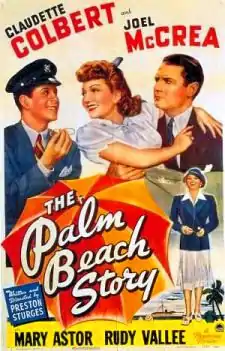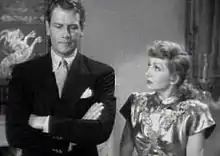The Palm Beach Story
The Palm Beach Story is a 1942 screwball comedy film written and directed by Preston Sturges, and starring Claudette Colbert, Joel McCrea, Mary Astor and Rudy Vallée. Victor Young contributed the lively musical score, including a fast-paced variation of the William Tell Overture for the opening scenes. Typical of a Sturges film, the pacing and dialogue of The Palm Beach Story are very fast.
| The Palm Beach Story | |
|---|---|
 theatrical release poster | |
| Directed by | Preston Sturges |
| Produced by | Buddy G. DeSylva (uncredited) Paul Jones (assoc. producer) |
| Written by | Preston Sturges |
| Starring | Claudette Colbert Joel McCrea Mary Astor Rudy Vallee |
| Music by | Victor Young |
| Cinematography | Victor Milner |
| Edited by | Stuart Gilmore |
| Distributed by | Paramount Pictures |
Release date | December 10, 1942 (NYC) January 1, 1943 (US general) |
Running time | 88 minutes |
| Country | United States |
| Language | English |
| Budget | $950,000 (approx)[1] |
| Box office | $1.7 million (US rentals)[2] |
Plot
Tom and Gerry Jeffers (Joel McCrea and Claudette Colbert) are a married couple in New York City who are down on their luck financially, which is pushing the marriage to an end. But there is a deeper problem with their relationship, just hinted at under the opening credits in the prologue, and only disclosed at the end.
The couple remain married from 1937 until 1942, when this story begins. Gerry decides that Tom would be better off if they split up. She packs her bags; takes some money offered to her by the Wienie King (Robert Dudley), a strange but rich little man who is thinking of renting the Jeffers' apartment; and boards a train for Palm Beach, Florida. There she plans to get a divorce and meet a wealthy second husband who can help Tom. On the train, she meets the eccentric John D. Hackensacker III (Rudy Vallée), one of the richest men in the world.

Because of an encounter with the wild and drunken millionaire members of the Ale and Quail hunting club, Gerry loses all her luggage; after making do with clothing scrounged from other passengers, she is forced to accept Hackensacker's extravagant charity. They leave the train and go on a shopping spree for everything from lingerie to jewelry – Hackensacker minutely noting the cost of everything in a little notebook, which he never bothers to add up – and make the remainder of the trip to Palm Beach on Hackensacker's yacht named The Erl King (a Sturges joke on the Hackensacker family business, oil).
Tom follows Gerry to Palm Beach by air, also with the impromptu financial assistance of the Wienie King. When Tom meets Hackensacker, Gerry introduces him as her brother, Captain McGlue. Soon, Hackensacker falls for Gerry, while his often-married, man-hungry sister, Princess Centimillia (Mary Astor), chases Tom, although her last lover, Toto (Sig Arno), is still following her around. To help further his suit with Gerry, Hackensacker agrees to invest in Tom's scheme to build an airport suspended over a city by wires.
Tom finally persuades Gerry to give their marriage another chance, and they confess their masquerade to their disappointed suitors. Even though he is disappointed, Hackensacker intends to go through with his investment in the suspended airport, since he thinks it is a good business deal and he never lets anything get in the way of business. Then, when Tom and Gerry reveal that they met because they are both identical twins – a fact which explains the opening sequence of the film – Hackensacker and his sister are elated. The final scene shows Hackensacker and Gerry's twin sister, and the Princess and Tom's twin brother, getting married, with Gerry and Tom standing as Maid of Honor and Best Man for both.
The film ends where it began after the prologue, with the words "And they lived happily ever after...or did they?" on title cards.
Cast
|
The Ale and Quail Club:
|
Cast notes
- This was Sturges' second collaboration with Joel McCrea, following Sullivan's Travels from the previous year and they would work together again on The Great Moment, which was filmed in 1942 (but released in 1944). Although Claudette Colbert and Sturges had both worked on The Big Pond (1930) and the first version of Imitation of Life (1934), The Palm Beach Story was the only time they worked together on a movie Sturges wrote and directed.
- The Palm Beach Story was Rudy Vallee's first comedic role and consequently he gained a contract with Paramount,[3] as well as an award for Best Actor of 1942 from the National Board of Review.[4] He would go on to appear in Sturges' The Sin of Harold Diddlebock, Unfaithfully Yours and The Beautiful Blonde from Bashful Bend.
- Many members of Sturges' unofficial "stock company" of character actors appear in The Palm Beach Story, among them Al Bridge, Chester Conklin, Jimmy Conlin, William Demarest, Robert Dudley, Byron Foulger, Robert Greig, Harry Hayden, Arthur Hoyt, Torben Meyer, Frank Moran, Charles R. Moore, Jack Norton, Franklin Pangborn, Victor Potel, Dewey Robinson, Harry Rosenthal, Julius Tannen and Robert Warwick.
- This was the seventh of ten films written by Preston Sturges in which William Demarest appeared.[5]
Production
At least part of the initial inspiration for The Palm Beach Story may have come to Preston Sturges from close to home, since his ex-wife, Eleanor Hutton, was an heiress who moved among the European aristocracy, and was once wooed by Prince Jerome Rospigliosi-Gioeni, among others, and Sturges himself had shuttled back and forth between Europe and America as a young man. Indeed, one incident in the film is based on something which happened to Sturges and his mother while traveling by train to Paris, when the car with their compartment was uncoupled while they ate dinner two cars away.[6]
The story Sturges came up with had the title Is Marriage Necessary?, and this, along with an alternative, Is That Bad?, became a working title for the film. Is Marriage Necessary? was rejected by the censors of the Hays Office, who also rejected the script that Paramount submitted to them because of its "sex suggestive situations...and dialogue." Changes were made, but the Hays Office continued to reject the script because of its "light treatment of marriage and divorce" and because of similarities between the John D. Hackensacker III character and John D. Rockefeller. More changes were made, including reducing the number of Princess Centimillia's previous marriages from eight to three (plus two annulments), before the script finally was approved.[3]
Claudette Colbert received $150,000 for her role, and Joel McCrea was paid $60,000.[6]
The second unit did background shooting at Penn Station in Manhattan. The film went into general release on 1 January 1943. The film was released on video in the U.S. on 12 July 1990 and re-released on 30 June 1993.[7]
Reception
In 1998, Jonathan Rosenbaum of the Chicago Reader included the film in his unranked list of the best American films not included on the AFI Top 100.[8]
In 2000, American Film Institute included the film in AFI's 100 Years...100 Laughs (#77).[9]
See also
- List of films with a 100% rating on Rotten Tomatoes, a film review aggregator website
References
- James Curtis, Between Flops: A Biography of Preston Sturges, Limelight, 1984 p162
- "101 Pix Gross in Millions" Variety 6 Jan 1943 p 58
- TCM Notes
- Allmovie Awards
- Demarest appeared in Diamond Jim (1935), Easy Living (1937), The Great McGinty (1940), Christmas in July (1940), The Lady Eve (1941), Sullivan's Travels (1941), The Palm Beach Story (1942), The Miracle of Morgan's Creek (1944), Hail the Conquering Hero (1944) and The Great Moment (1944)
- Stafford, Jeff "The Palm Beach Story" (TCM article)
- "The Palm Beach Story (1942) - Misc Notes - TCM.com". Turner Classic Movies. Retrieved 19 April 2016.
- Rosenbaum, Jonathan (June 25, 1998). "List-o-Mania: Or, How I Stopped Worrying and Learned to Love American Movies". Chicago Reader. Archived from the original on April 13, 2020.
- "AFI's 100 Years...100 Laughs" (PDF). American Film Institute. 2002. Retrieved August 22, 2016.
External links
| Wikimedia Commons has media related to The Palm Beach Story (1942 film). |
| Wikiquote has quotations related to: The Palm Beach Story |
- The Palm Beach Story at IMDb
- The Palm Beach Story at the TCM Movie Database
- The Palm Beach Story at AllMovie
- The Palm Beach Story at the American Film Institute Catalog
- Archival NYTimes Review By Bosley Crowther, December 11, 1942
- Greatest Films- The Palm Beach Story Critique and thorough plot description/analysis.
- The Palm Beach Story at Portico
- The Palm Beach Story on Screen Guild Theater: March 15, 1943
- The Palm Beach Story: Love in a Warm Climate an essay by Stephanie Zacharek at the Criterion Collection

